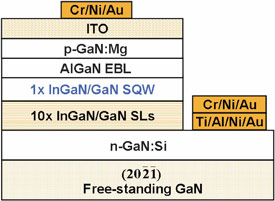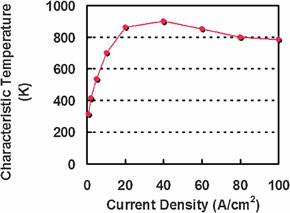- News
3 October 2012
Thermal droop improved in semi-polar nitride semiconductor LEDs
Researchers from University of California, Santa Barbara (UCSB) have measured thermal droop for the first time in semi-polar nitride semiconductor light-emitting diodes (LEDs) [Chih-Chien Pan et al, Appl. Phys. Express, vol5, p102103, 2012]. In line with previous experiments on efficiency droop, the researchers found improved thermal stability for the semi-polar devices, compared with traditional polar c-plane LEDs.
Nitride-based LEDs show efficiency degradation at high current (current droop) and high temperatures (thermal droop). These behaviors limit the performance of nitride LEDs for applications such as automotive headlights, interior/exterior lighting, and full-color displays.
UCSB has developed LEDs on semi-polar nitride materials with (20-2-1) crystal orientation. Their previous work has achieved current droops of just 4% at 100A/cm2 current density from a peak external quantum efficiency (EQE) of 50%. For conventional c-plane LEDs the comparative current droop is of the order 40% at the same current density.
The researchers used on-axis free-standing (20-2-1) GaN substrates from Mitsubishi Chemical to produce epitaxial material through metal-organic chemical vapor deposition (MOCVD). LEDs were produced (Figure 1) that were mounted on ceramic plates and tested in a customized integrating sphere fitted with a thermoelectric cooler (TEC). Pulse operating conditions were used to avoid uncontrolled self-heating effects. The pulse length varied between 30msecs and 10 seconds.
 Figure 1: LED structure on semi-polar (20-2-1) free-standing GaN.
Figure 1: LED structure on semi-polar (20-2-1) free-standing GaN.
The external quantum efficiency of the devices gradually declined with increasing temperature. A lower EQE was seen compared with the previous experiments on devices that were encapsulated in silicone. The researchers believe the decline with temperature is due to the effects of non-radiative recombination, Auger recombination and carrier leakage.
The maximum EQE occurs at around 40A/cm2 current density. The thermal droop was given as the decrease in EQE between 20°C and 100°C as a fraction of the EQE at 20°C (Figure 2). For 1A/cm2 current density the thermal droop was 22.5%, and at 100A/cm2 9.7%. The droop was less than 10% for current densities greater than 20A/cm2. The high thermal droop at lower current densities is attributed to the more temperature-dependent Shockley-Read-Hall (SRH) mechanism of non-radiative recombination through states in the bandgap. Thermal droop in c-plane LEDs is typically more than 20% at 100A/cm2.
 Figure 2: Current-density-dependent (a) external quantum efficiency, and (b) thermal droop as a function of temperature for UCSB semi-polar SQW blue LED. Inset: Hot/cold factor as a function of current density, comparing EQEs at 100°C and 20°C.
Figure 2: Current-density-dependent (a) external quantum efficiency, and (b) thermal droop as a function of temperature for UCSB semi-polar SQW blue LED. Inset: Hot/cold factor as a function of current density, comparing EQEs at 100°C and 20°C.
The researchers also used their results to extract a characteristic temperature relative to performance at 293K (20°C). Conventional c-plane devices have a Tc around 170K, but the UCSB semi-polar devices had a Tc of almost 900K, both values being determined at 40A/cm2. The researchers comment that higher values of Tc show improved output power stability as a function of temperature for the semi-polar devices.
The researchers also investigated junction temperature under DC operating conditions. At 100A/cm2, the junction temperature was around 68°C, according to the dependence of forward voltage on temperature. An infrared camera gave a similar figure of around 64°C.
The researchers see the improved performance over c-plane devices as coming from the material being relatively free of indium fluctuations. Such fluctuations in c-plane devices cause carrier localization and band filling. These lead to pockets of increased carrier densities where Auger recombination and carrier leakage can eat away at radiation efficiency and reduce the effective active region volume.
 Figure 3: Characteristic temperature as function of current density for UCSB semi-polar SQW blue LED.
Figure 3: Characteristic temperature as function of current density for UCSB semi-polar SQW blue LED.
The UCSB structure uses a thick 12nm single quantum well (SQW), rather the more usual multi-quantum wells of 2 or 3nm.
The researchers comment: “In our semi-polar (20-2-1) LEDs, polarization-related electric fields are significantly reduced; an SQW active region eliminates carrier non-uniformity issues. Additionally, the thick high-quality homogeneous InGaN layer grown at a relatively high growth temperature reduces the effects of potential fluctuations and lowers the average carrier density. The result is a much larger effective active region volume than that of conventional c-plane LEDs. This reduces the effects of Auger recombination and carrier leakage by reducing the carrier density, resulting in a device with a low efficiency droop.”
These same factors are also thought to improve the thermal droop behavior.
Layer insertion to avoid nitride LED efficiency droop
Semi-polar nitride semiconductor LEDs LED droop GaN MOCVD
http://apex.jsap.jp/link?APEX/5/102103
The author Mike Cooke is a freelance technology journalist who has worked in the semiconductor and advanced technology sectors since 1997.


